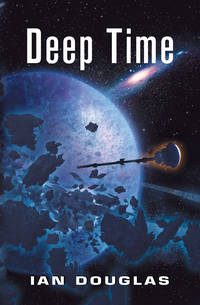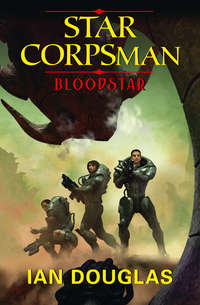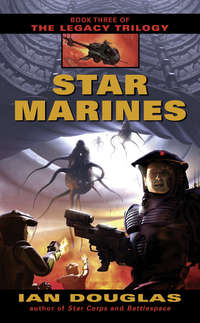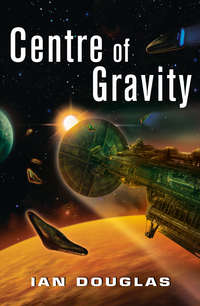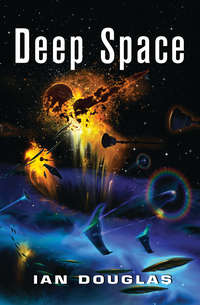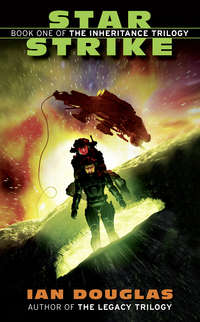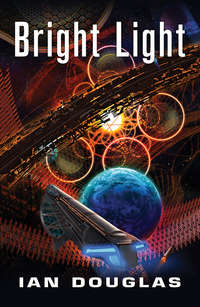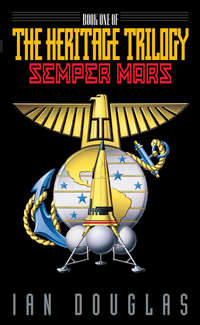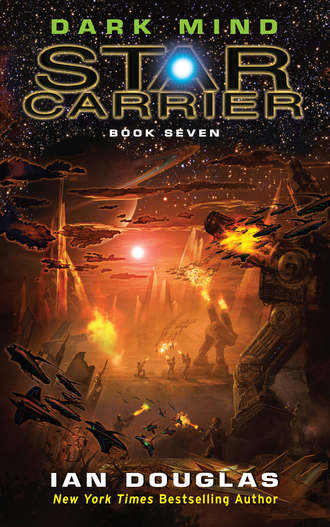
Полная версия
Dark Mind
Lieutenant Donald Gregory
VFA-96, Black Demons
0516 hours, TFT
“Pull back and cover the America, people,” Mackey ordered. “They’re using fucking kamikaze tactics! We’ve got to stop them from getting through!”
Gregory had heard the order from the carrier’s CIC already, and had witnessed both the destruction of the Verdun and the damage done to America herself.
It was a hopeless fight. So far, he’d run through about half of the missiles in his magazine, but as the fighting enveloped the carrier more and more tightly, he was having to shift to his Gatling cannon, firing high-velocity kinetic-kill rounds of depleted uranium. Nuclear detonations were tricky things to employ close to the hulls of friendly ships, and the USNA fighter pilots were being forced to use more surgical methods in their defensive tactics.
Surgical methods took longer—you couldn’t yell “Fox One” and blow a dozen enemies away with a single highyield detonation, and you had to be frustratingly precise in the placement of your warshots.
One alien fighter, gleaming silver and irregular in shape, came in across America’s stern and raced up the length of her spine, Gregory in close pursuit. He fired a burst of KK rounds, but the angle was bad and the rounds glanced off the hurtling spacecraft with minimal damage. The rounds that missed slammed into the underside of the carrier’s shield cap forward … though with minimal damage as well, thank the gods. The carrier’s hull shields absorbed or deflected much of the impact.
For a terrifying moment, he thought the enemy craft was trying for one of America’s three landing bays in the steadily rotating hab section … but the fighter slipped between two of the moving bays and plunged toward the blunt, forwardleaning tower between hab module and the underside of the shield cap.
Damn! They were trying for the bridge and CIC!
The alien vessel struck the bridge tower at its base, just above the main hull of the carrier’s spine; Gregory’s Starblade flashed past an instant later, twisting around his grav singularity and angling out and away from the carrier. Braking hard, he reversed course and dropped toward the ship’s spine again, gliding past the blurred hull metal of the bridge tower. His AI signaled a target lock on the alien, which was melting now into America’s hull, sinking through the low-level bending of space, just above the ship’s outer hull, which deflected incoming energies. In another moment it would detonate, and the carrier might lose its bridge and combat information center all at once.
Gregory triggered his KK Gatling, sending a stream of high-velocity rounds slamming into and through the enemy craft. A particle-beam shot might do too much damage, though in fact he didn’t have the time to give the decision any conscious thought. He aligned with the target and fired, watching white flares of heat and light and splashes of molten metal erupt from the partially sunken alien hull.
At the last instant, he pulled out, whipping around his drive singularity and using a tremendous burst of acceleration to shove his ship sideways to avoid becoming a kinetic-kill projectile himself.
He held his breath, waiting for the alien to explode.
It didn’t.
“America CIC,” he called, “this is Demon Four! You have an enemy bogie buried in the bridge tower!”
“We copy that, Demon Four. Acknowledged.”
“Better send some Marines in case they’re still alive.” And in case there’s a loose black hole inside the wreckage, he added to himself … but he didn’t say so aloud. The shipboard response teams knew their business.
“Copy that, Four. Thanks for the assist.”
“All part of our friendly Black Demon service,” he replied, with a nonchalance that he definitely did not feel. That had been too damned close for sanity!
And they say the definition of insanity is doing the same thing over and over again and expecting different results. So here I go again …
A group of eight alien fighters were inbound, a thousand kilometers out. He locked on and fired one of his dwindling number of Kraits. The detonation moments later took out seven of the eight; he nailed the survivor with another burst from his Gatling, watching the wreckage collapse in upon itself, folding up tighter and tighter until it vanished in a surprised pop of hard X-rays.
That was proof that the Sh’daar fighters had power taps similar to what the human ships were using—tiny black holes that skimmed energy from the frothing virtual energy at the base of reality and made it real. When a ship was destroyed, the black hole inside often ate much of the wreckage, then evaporated. Sometimes the singularity hung around long enough to become a menace to navigation, but luckily that wasn’t the case this time.
Unluckily, there were more opportunities, because beyond those eight Sh’daar ships another ten were approaching at high speed.
“Damn it,” Gregory snapped. “How many of these things are there?”
His Starblade’s AI gave him an answer, though as an impression, an unspoken realization, rather than in words. More than six thousand, out of an original estimated nine thousand …
Too fucking many. They’d destroyed thousands of the things already … but thousands more remained.
“All ships, this is America CIC,” a voice announced. “Be aware … we have more Sh’daar vessels inbound, repeat, more Sh’daars inbound. Capital ships, this time …”
Great! he thought. Just fucking great!
TC/USNA CVS America
Flag Bridge/CIC
0535 hours, TFT
Admiral Gray stared into the mass of alien vessels headed for the battlegroup from dead ahead. America’s tactical AIs had counted over three hundred so far, including a couple of monsters that must have started out as planetoids, kilometers across and massing billions of tons.
There would be no escape from so powerful an alien force …
He saw exactly three different tactical options—surrender, fight to the death, or order the fleet to scatter in the hope that a few of the battlegroup’s ships, at least, might make it back through the TRGA and reach home. None of those choices was particularly appealing … and a fourth option emerged.
“Open a channel to that fleet,” he told the communication officer on America’s bridge. “Use the Agletsch protocols. See if they’re willing to talk.”
“They are already willing to talk, Admiral.” The voice was that of Konstantin—or, rather, of a clone of that powerful AI. “I am now in communication with them.”
The Konstantin clone was resident within the TOAF module, a cylinder strapped to America’s spine aft of the rotating hab section, but was linked in through the carrier’s electronic network to America’s resident AIs. It hadn’t spoken before, and Gray had more or less forgotten that it was there, but he welcomed its input now.
“What do they say, Konstantin?”
There was a brief but agonizing pause.
“The force ahead is siding with us,” the AI told him. “The small Sh’daar fighters appear to be … they are calling them counter-Refusers, which is confusing, but the word rebels may approximate the meaning.”
“Counterrevolutionaries?” Gray suggested. He’d encountered the term once in a downloaded history of twentieth-century global politics.
“Indeed. The Sh’daar, remember, began as what they termed Refusers, rejecting the ur-Sh’daar Schjaa Hok.”
“‘The Transcending,’” Gray said, giving the alien term its closest English translation. “I remember.”
They’d learned that bit of history twenty years ago, during the Koenig Expedition to this spacetime. Originally, the N’gai dwarf galaxy had been occupied by hundreds of mutually alien civilizations that humans now knew as the ur-Sh’daar … the original or primal Sh’daar. When that galactic culture had entered its own version of the technological singularity almost a billion years in Humankind’s past, some, for various reasons, had rejected or somehow avoided the transformation, becoming known as “Refusers.”
“Are you telling me that these fighter swarms are Sh’daar who embrace the ur-Sh’daar Transcending?”
“I do not yet have enough data on Sh’daar ideologies or political interactions to say with certainty,” Konstantin replied. “However, that is certainly a valid possibility.”
“So why the hell were they attacking us?”
“I do not have enough information as of yet to give you a meaningful reply,” Konstantin told him. “But this rebel subgroup must feel threatened by our arrival in some way. Perhaps they wish to join the original ur-Sh’daar, and fear that we would threaten or delay their plans.”
“Hell, if they want to go, let them,” Gray said. “Attacking us without provocation isn’t a rational act.”
“Again, Admiral, I would caution you that we lack hard data as to their motives, needs, and aspirations. It’s too early to speculate concerning their actions.”
Damned machine. “Let me know when you have hard data.”
“Of course.”
“In the meantime, what about our new best buddies out there?”
The Sh’daar vessels ahead were spreading out. America’s long-range sensors were detecting bursts of gamma radiation—evidence of positron annihilation. The aliens were using antimatter weaponry.
“They appear to be attacking the rebels, Admiral.”
“You’re saying they’re rescuing us?”
“So it would appear, Admiral.”
“All ships,” Gray said, using the battlegroup’s tactical channel. “Disengage and pull back. The cavalry’s just galloped in to the rescue. Stay clear and let them do their thing.”
Sh’daar fighters continued to press their attack on the America battlegroup, trying to overwhelm the human defenses … but the fleet of capital ships was moving in swiftly, now, using precisely wielded bursts of antimatter particles to vaporize the minute alien ships.
And then the surviving alien fighters were breaking off and fleeing, scattering out and away and into the surrounding cloud of densely packed suns.
“Admiral, the Adjugredudhran commander of the Sh’daar flagship Ancient Hope gives you its greetings,” Konstantin reported. “It hopes our force has not suffered serious loss … and regrets the counter-Refuser attack on our vessels. It suggests that we follow the Sh’daar fleet into the Core … to the vicinity of the Six Suns.”
Gray let out a pent-up breath. He felt weak … shaky enough that he wondered if he would have been able to stand in a full gravity. So close …
“Please thank the Ad … thank the Sh’daar commander,” he replied, “and tell it that we will comply.”
“Well,” Mallory said out loud. He’d obviously been listening in on the conversation with Konstantin. “Let the diplomacy games begin.”
“Better with words than with particle cannon,” Gray said with a shrug. “I guess it’s a good thing we brought Konstantin-2 out here.”
“It would’ve been nice if the good guys had been here to meet us,” Mallory said. “I don’t trust this.”
“Neither do I, Dean. But let’s see what they have to say.”
And the battlegroup—the ten survivors, at any rate, plus the Glothr liaison ship—fell into formation with the far more numerous locals.
Admiral Gray looked at the nearest of the Sh’daar vessels—a monster wedge five kilometers long, its hull gliding past a few kilometers away like a massive black cliff dotted with city lights …
… and felt very, very small.
Chapter Four
29 October 2425
New White House
Washington, D.C.
United States of North America
0840 hours, EST
“So what’s up on the docket for today?” President Koenig asked.
Marcus Whitney, Koenig’s White House chief of staff, laid a secure data pad on the high-tech desk before him. “You had a nine-hundred with the Pan-Euro ambassador, sir, and an eleven-hundred with the Periphery reclamation council from Northern Virginia …”
“‘Had?’”
“Yes, sir. I rescheduled. Konstantin wants to vir-meet with you.”
“Konstantin? Wants to see me?” Generally, it was the other way around. “What about?”
“He has not divulged his agenda, Mr. President.”
The powerful AI rarely mixed its affairs with those of humans. Even so, its effects on human culture, technology, and politics had been far reaching indeed. Its input had effectively ended the USNA’s conflict with the Confederation government by employing memetic weaponry to turn civilian support against the war. It continually monitored news feeds and imagery from around the Earth, making suggestions that had averted famines, alleviated plagues, and blocked wars. It had guided presidents in both military and political exchanges both with other human states and with aliens.
Ever since Koenig had taken office as president, Konstantin had been an unofficial and highly secret special advisor. The strange thing was that the machine intelligence—not a human agency or department—seemed to have developed the idea.
And Koenig had no idea what the AI’s true motivations might be.
“I guess,” he said slowly, “I’d better find out what he wants. See that I’m not disturbed, Marcus.”
“Yes, sir.”
As his aide left the office, Koenig leaned back in his chair, which reshaped itself to more comfortably fit his frame. He placed the palm of his left hand on a smooth, glassy plate set into the chair’s arm and on the desk, the datapad winked on …
… and Koenig opened his eyes inside a small and dimly lit log cabin in Kaluga, Russia. An elderly man—white-haired, goateed, with wire-frame pince-nez and a sleepy expression—looked up from an old-fashioned book.
“Hello, Konstantin,” Koenig said. “You wanted to see me?”
As always, Koenig had the feeling that the figure before him was studying him narrowly, with a superhuman intensity quite at odds with the sleepy expression on its very human face. Everything was an illusion, of course, created by the AI and downloaded into Koenig’s mind through the virtual reality software running on his cerebral implants. The anachronistic touches demonstrated that—the real Konstantin Tsiolkovsky never had banks of high-definition monitors on the walls of his log house. Nor had the famous Russian pioneer of astronautic theory spoken English.
“Yes, Mr. President. It is time that you and I had a chat. I have some information that may be of interest.”
“You haven’t heard from your clone on the America yet …”
“No. If our calculations are correct, they have only just arrived at the N’gai Cloud … if, indeed, the two different time frames can be meaningfully compared. But we have heard from the Agletsch. They have made available some information. Gratis.”
“They gave it to us?” Koenig was impressed. “That means it’s either worthless … or of unbelievably high value.”
“Agreed.”
The Agletsch exchanged information from across a vast swath of the galaxy for other information, as well as for certain rare elements—notably isotopes of neptunium and californium. They never gave stuff away for free.
Not unless it very definitely benefited them as well.
“So what’s the information?”
Koenig waited out the slight time delay. It took one and a quarter seconds for his words to reach Konstantin on Luna’s far side, another second and a quarter for the answer to return. Every exchange had a built-in 2.5-second pause.
“They strongly suggest that we check out Tabby’s Star,” Konstantin told him.
“I don’t know that one,” Koenig said. “At least not by that name.”
“Here is the download.”
Information flooded through Koenig’s implants and into his conscious awareness.
A mental window opened, filling with scrolling text.
Object: KIC 8462852
Alternate names: WTF Star, Tabby’s Star
Type: Main-sequence star; Spectral Type: F3 V/IV
Coordinates: RA: 20h 06m 15.457s Dec: + 44° 27′ 24.61″
Constellation: Cygnus
Mass: ~ 1.43 SOL; Radius: 1.58 SOL;
Rotation: 0.8797 DAYS
Temperature: 6750° K; Luminosity: 5 SOL
Apparent Magnitude: 11.7;
Absolute Magnitude: 3.08
Distance: 1480 LY
Age: ~ 4 billion years
Notes: First noted in 2009–2015 as a part of the data collected by the Kepler space telescope. An extremely unusual pattern of light fluctuations proved difficult to explain as a natural phenomenon, and raised the possibility that intermittent dips in the star’s light output were the result of occultations by intelligently designed alien megastructures.
KIC 8462852 received the unofficial name “Tabby’s Star” after Tabetha S. Boyajian, head of the citizen scientist group that first called attention to the object. It was also called the “WTF star”—a humorous name drawn from the title of her paper: “Where’s the Flux?” At that time, “WTF” was a slang expression of surprise or disbelief.
The Tabby’s Star anomalies were eventually explained as a combination of an accretion disk and odd stellar geometry brought on by the star’s high rate of spin and resultant gravitational darkening …
There was a lot more information in the download, and Koenig waded through it. He wasn’t familiar with much of it.
In the early twenty-first century, the Kepler space telescope had continuously monitored the light coming from some 150,000 stars in a small section of Cygnus; planets orbiting those stars would periodically block a tiny percentage of the light, causing dips in the stars’ brightness.
That period, from 2009 through 2015, was a heady one of exploration and discovery, as thousands of exoplanets, worlds outside of Sol’s domain, were found, and Humankind became aware of the fact that the Milky Way alone might contain 40 billion worlds like Earth. Out of all of those target stars, however, only one had showed a light curve as bizarre as one sun at the very edge of the target area: KIC 8462852. Light dips were frequent, sharp, and aperiodic—behaving like large numbers of huge objects orbiting their star “in tight formation,” as one astronomer put it. One particular object did seem to have a regular period. The first time it was spotted, it obscured 15 percent of the star’s light. The second time, 750 days later, it obscured 22 percent of the light.
Twenty-two percent? A super-Jupiter, the largest world possible, typically obscured about 1 percent of the light from its star as it passed in front of the star’s disk. To cause that big of a drop in the light output of the star, the eclipsing object would have to be so large it covered nearly a quarter of the star’s face. This could not be a planet, so what the hell was it?
Dozens of theories were fielded—possible natural explanations, including huge dust clouds, masses of perturbed comets, and colliding planets. None worked very well. The system was too old to have dust clouds or accretion disks, the chances of finding it just when planets had collided or comets descended were nil, and the amount of detectable infrared radiation was a bad fit for all of those possibilities.
Increasingly, astronomers were forced to consider the unthinkable—that the odd light curve of KIC 8462852 was due to some sort of alien megastructure, an intelligently designed and built structure or series of structures, such as a Dyson sphere under construction or, more likely, a Dyson swarm—thousands of objects absorbing energy from the star. The light curves seemed to suggest solid-edged, irregularly shaped structures with distinct boundaries rather than diffuse clouds of dust.
But the alien megastructure idea had to be the very last possibility to be considered. That was not because the astronomers didn’t want to think about aliens, but because the alien hypothesis was not falsifiable by scientific testing … and so it could not be considered until every other possibility had been tested and ruled out.
And eventually, a natural explanation was found. Fast-spinning stars could suffer an effect called gravitational darkening while flattening from a sphere into an oblate spheroid; several large planets transiting across different parts of the star’s surface, plus an accretion disk of dust, could cause greater or lesser dips in the light curve.
There were problems with that theory, though. The star did spin quickly—at the equator it rotated once in 21 hours and a few minutes as opposed to 25 days for Sol—but not fast enough to cause severe distortion of the sphere. And, again, the star just wasn’t young enough to have an orbiting cloud or accretion disk of dust.
But by that time, the twenty-first century had been in free fall toward utter chaos. Stunning and widespread political corruption, quickly rising sea levels, economic collapse, global war with Islam, the First Sino-Western War, and the ravages of the Blood Death … it was a wonder, frankly, that Humankind had survived. The hanging of the first space elevator, in the twenty-second century, had helped reverse the collapse, bringing in the raw materials, cheap energy, and improved technologies that ultimately transformed the planet.
But as Humankind began to establish a firm foothold in the solar system, the excitement over KIC 8462852 was largely forgotten. It became an interesting anomaly, quickly explained and as quickly filed away and ignored.
“Okay,” Koenig said after several minutes reviewing the material. “An interesting observation, but it says here they explained it. Why are the Agletsch interested in the thing? Or, maybe I should say … why do they want us to be interested?”
“They did not discuss that,” Konstantin replied. “But they seem to believe that our explanation was wrong. That Tabby’s Star is in fact the location of an advanced alien civilization.”
“But not an ally of the Sh’daar, I take it.”
“Correct.”
Humankind now understood that the Sh’daar were interlopers from the remote past, from T-0.876gy … a term usually abbreviated as “Tee-sub-minus,” or, in other words, from 876 million years in the past. They appeared to have recruited a number of alien civilizations in Tprime (meaning time now, the twenty-fifth century): the Turusch, the H’rulka, the Nungiirtok, the Slan, and quite a few others. That alliance, called the Sh’daar Collective, had been deployed against Humankind in an effort to force them to give up tech-singularity-inducing technologies. The Collective apparently extended into the future as well; the Glothr, from a rogue planet millions of years in the future, might well have been working with the Sh’daar, though the nature of that relationship was still uncertain.
The only reason Humankind had survived against that alliance as long as it had was the fact that the different members of the Sh’daar Collective had as much trouble communicating with one another as they did with humans. Organizing a joint military campaign across millions of years and with dozens of space-faring species with wildly diverse means of communicating turned out to be damned near impossible.
“Huh,” Koenig said, thoughtful. “If the Tabby’s Star aliens haven’t been pressured by the Sh’daar, they might turn out to be useful allies for us.”
“Exactly. Assuming, of course, that they care to involve themselves with humans.”
“What … they might not because we’re so primitive? Or would they be put off by our body odor?”
“Whatever terrestrial astronomers observed at Tabby’s Star in the year 2015,” Konstantin reminded Koenig, “would have happened 1480 years earlier … in the year 535 C.E., to be precise. If they were actually building a Dyson sphere when Europe’s Dark Ages were just getting started, where are they, and what are they building now? Such beings might seem like gods compared to humans.”


